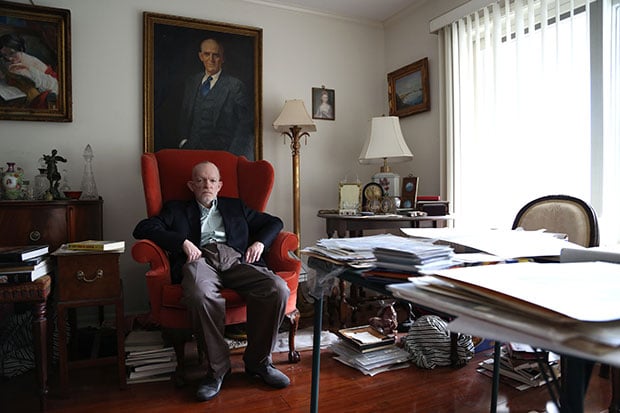“Nothing’s original under the sun, you know. Everything goes back to something.”
These are the words uttered by Mark Landis at the beginning of Sam Cullman and Jennifer Grausman’s Art and Craft, which explores the stranger-than-fiction story of Landis—a Virginia native, a diagnosed schizophrenic, and one of the most skilled and prolific art forgers in American history. In his cluttered apartment, he laboriously creates pitch-perfect copies of works by artists ranging from Pablo Picasso to Paul Signac to Charles Schulz. But he doesn’t sell them—instead, he takes them to museums across the country while under various aliases (including a Jesuit priest) and “donates” them, claiming the contributions are at the bequest of one fictional deceased relative or another. Landis calls himself a “philanthropist,” and his methods manage to get more than 100 of his forgeries into an astonishing 46 museums across 20 states. And he might have continued in the same vein indefinitely, were it not for a determined University of Cincinnati registrar named Matt Leininger, who discovers the fakes and embarks on a personal crusade to expose Landis, losing his job and gaining an obsession in the process.
Parts of Art and Craft feel almost like a caper film, as when the filmmakers follow Landis donning his disguises and road-tripping from city to city with a briefcase full of fake masterpieces. Other times it’s more simple, the story of a lonely man living with mental illness, devastated by the loss of his mother and with only TV shows and movies to keep him company and shape his world view. (In a scene at the clinic where he’s treated for schizophrenia, the clinician asks after his mother, unaware that she died more than two years prior.) It’s clear Landis has mental issues; what’s less clear is whether what he’s doing is actually illegal. Most of the curators he’s duped seem more embarrassed than angry (with the exception of Leininger), and Landis has never been prosecuted nor attempted to cover up or deny what he’s doing. Even after the New York Times publishes a feature on him and includes his picture, leading to dozens of other news stories, Landis doesn’t stop. In fact, he almost seems to enjoy the attention.
The film meanders at times, spending long chunks focused on Landis’s face as he explains how he tries to emulate characters from classic films, or why he smokes the occasional cigarette (another affectation picked up from movies and TV), or how he had a nervous breakdown at the age of 17. The climactic scene, as it were, centers on the opening of a curated show of Landis’s forgeries. At long last, Leininger once again meets his nemesis face to face—and seems to find himself at a loss for what to say.
Art and Craft raises interesting questions—Is Landis an artist or just a savant? An eccentric or a crook?—but ultimately offers little by way of a conclusion. At the gallery opening, several people approach Landis to praise his work, and unfailingly they suggest to him he use his talents to create original works. “I made ‘The Young Virgin,’” he tells them, pointing to a portrait he sketched of his mother as a young woman—copied, in perfect detail, from a photograph.
Screening Friday, June 20, 9 PM at the Naval Heritage Center, and Saturday, June 22, 1 PM at AFI Silver Theatre.
Return to AFI Docs page.


















